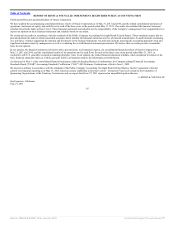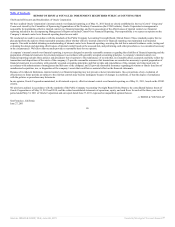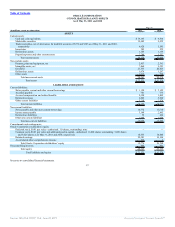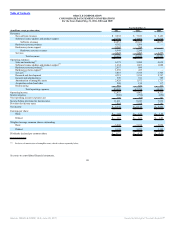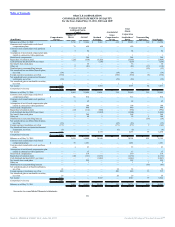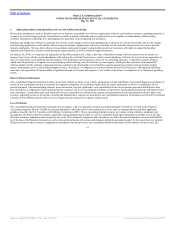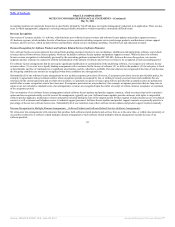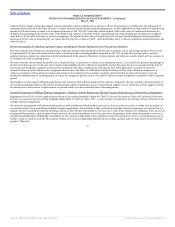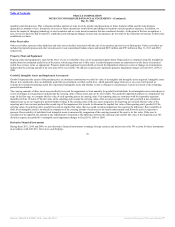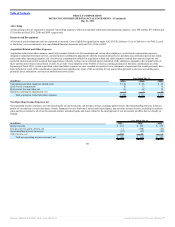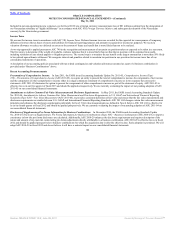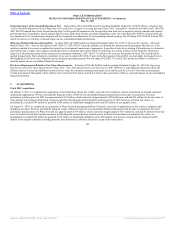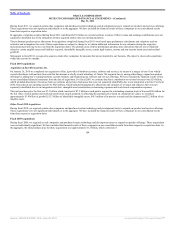Oracle 2010 Annual Report Download - page 98
Download and view the complete annual report
Please find page 98 of the 2010 Oracle annual report below. You can navigate through the pages in the report by either clicking on the pages listed below, or by using the keyword search tool below to find specific information within the annual report.
Table of Contents
ORACLE CORPORATION
NOTES TO CONSOLIDATED FINANCIAL STATEMENTS—(Continued)
May 31, 2011
aforementioned criteria for a separate unit of accounting are not met, the deliverable is combined with the undelivered element(s) and treated as a single unit of
accounting for the purposes of allocation of the arrangement consideration and revenue recognition. For those units of accounting that include more than one
deliverable but are treated as a single unit of accounting, we generally recognize revenues over the delivery period. For the purposes of revenue classification of
the elements that are accounted for as a single unit of accounting, we allocate revenue to hardware systems and services based on a rational and consistent
methodology utilizing our best estimate of fair value of such elements.
For our nonsoftware multiple-element arrangements, we allocate revenue to each element based on a selling price hierarchy at the arrangement inception. The
selling price for each element is based upon the following selling price hierarchy: VSOE if available, third party evidence (TPE) if VSOE is not available, or
estimated selling price (ESP) if neither VSOE nor TPE are available (a description as to how we determine VSOE, TPE and ESP is provided below). If a tangible
hardware systems product includes software, we determine whether the tangible hardware systems product and the software work together to deliver the
product’s essential functionality and, if so, the entire product is treated as a nonsoftware deliverable. The total arrangement consideration is allocated to each
separate unit of accounting for each of the nonsoftware deliverables using the relative selling prices of each unit based on the aforementioned selling price
hierarchy. We limit the amount of revenue recognized for delivered elements to an amount that is not contingent upon future delivery of additional products or
services or meeting of any specified performance conditions.
To determine the selling price in multiple-element arrangements, we establish VSOE of selling price using the price charged for a deliverable when sold
separately and for software license updates and product support and hardware systems support, based on the renewal rates offered to customers. For nonsoftware
multiple-element arrangements, TPE is established by evaluating similar and interchangeable competitor products or services in standalone arrangements with
similarly situated customers. If we are unable to determine the selling price because VSOE or TPE doesn’t exist, we determine ESP for the purposes of allocating
the arrangement by reviewing historical transactions, including transactions whereby the deliverable was sold on a standalone basis and considering several other
external and internal factors including, but not limited to, pricing practices including discounting, margin objectives, competition, the geographies in which we
offer our products and services, the type of customer (i.e. distributor, value added reseller, government agency and direct end user, among others) and the stage of
the product lifecycle. The determination of ESP is made through consultation with and approval by our management, taking into consideration our pricing model
and go-to-market strategy. As our, or our competitors’, pricing and go-to-market strategies evolve, we may modify our pricing practices in the future, which
could result in changes to our determination of VSOE, TPE and ESP. As a result, our future revenue recognition for multiple-element arrangements could differ
materially from our results in the current period. Selling prices are analyzed on an annual basis or more frequently if we experience significant changes in our
selling prices.
Revenue Recognition Policies Applicable to both Software and Nonsoftware Elements
Revenue Recognition for Multiple-Element Arrangements – Arrangements with Software and Nonsoftware Elements
We also enter into multiple-element arrangements that may include a combination of our various software related and nonsoftware related products and services
offerings including hardware systems products, hardware systems support, new software licenses, software license updates and product support, consulting,
Cloud Services and education. In such arrangements, we first allocate the total arrangement consideration based on the relative selling prices of the software
group of elements as a whole and to the nonsoftware elements. We then further allocate consideration within the software group to the respective elements within
that group following the guidance in ASC 985-605 and our policies as described above. After the arrangement consideration has been allocated to the elements,
we account for each respective element in the arrangement as described above.
94
Source: ORACLE CORP, 10-K, June 28, 2011 Powered by Morningstar® Document Research℠



